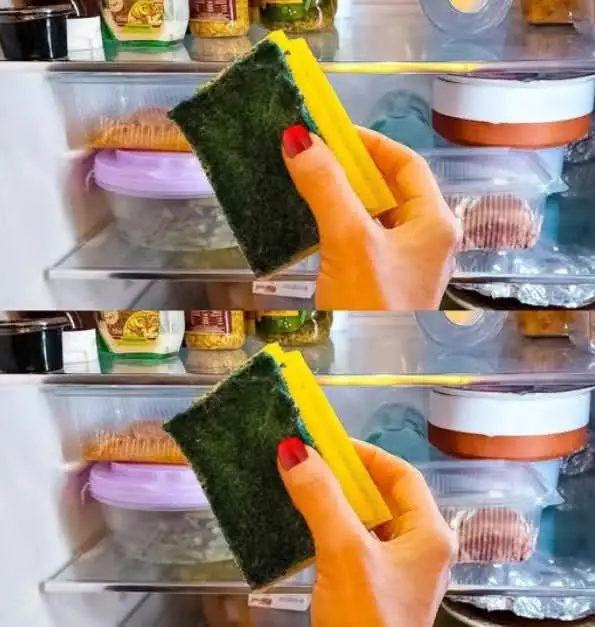Have you ever opened your refrigerator, only to find that your fresh produce has wilted or spoiled prematurely? It’s a common frustration, leading to unnecessary food waste and added expenses. Surprisingly, a simple kitchen sponge might be the solution to this pervasive problem.
The Moisture Dilemma in Refrigerators
Refrigerators are designed to preserve our food by maintaining a cool environment. However, they can also harbor excess moisture, especially in the crisper drawers where fruits and vegetables are stored. This moisture can accelerate the decay process, causing produce to rot faster than expected. Mold growth and unpleasant odors are additional unwelcome consequences of this damp environment.
The Sponge Solution
Enter the humble kitchen sponge—a tool traditionally used for cleaning dishes and surfaces. Beyond its cleaning capabilities, a sponge’s absorbent nature makes it an excellent candidate for moisture control. By placing a clean, dry sponge in your refrigerator’s produce drawer, you can effectively reduce excess humidity. The sponge absorbs the moisture, creating a drier environment that helps extend the shelf life of your fruits and vegetables.
Implementing the Sponge Trick
To maximize the benefits of this method, follow these steps:
- Clean Your Refrigerator: Before introducing the sponge, ensure your refrigerator is spotless. Remove all items and thoroughly clean the interior to eliminate any existing mold or bacteria. This sets a hygienic foundation for your produce storage.
- Select the Right Sponge: Opt for a high-quality, absorbent sponge. Microfiber sponges are particularly effective due to their superior absorption capabilities.
- Placement: Position one or two dry sponges in the crisper drawer alongside your produce. Ensure they don’t directly touch the food to prevent any potential contamination.
- Maintenance: Regularly check the sponges for moisture accumulation. Once they become damp, remove, wring out, and allow them to dry completely before reinserting them into the drawer. For optimal hygiene, consider replacing the sponges periodically.
Additional Tips for Prolonging Produce Freshness
While the sponge trick is a valuable tool, combining it with other best practices can further enhance your produce’s longevity:
- Separate Fruits and Vegetables: Some fruits emit ethylene gas, which can hasten the ripening of nearby vegetables. Store them in separate compartments to prevent premature spoilage.
- Use Perforated Bags: Placing produce in perforated bags allows for adequate air circulation, reducing moisture buildup and extending freshness.
- Remove Spoiled Items Promptly: Regularly inspect your produce and discard any items showing signs of spoilage. This prevents mold from spreading to other foods.
The Science Behind the Sponge Method
Understanding the rationale for placing a sponge in the refrigerator involves basic principles of moisture control. Excess humidity in the fridge creates an environment conducive to mold growth and accelerates the decay of fresh produce. By introducing an absorbent material like a sponge, you actively manage and reduce this moisture, thereby preserving the quality and extending the shelf life of your food.
Alternative Uses for Kitchen Sponges
Beyond moisture control in the refrigerator, kitchen sponges offer a range of practical applications:
- DIY Ice Packs: Soak a sponge in water, place it in a sealable plastic bag, and freeze it. This creates a flexible ice pack suitable for relieving minor injuries or keeping lunchboxes cool.
- Cleaning Hard-to-Reach Areas: Cut a sponge into smaller pieces to clean tight spaces, such as the grooves of a blender or the tracks of sliding doors.
- Soap Saver: Place a dry sponge at the base of your soap dish to absorb excess water, preventing the soap from becoming mushy and extending its usability.
Maintaining Kitchen Hygiene
While sponges are versatile and useful, they can also harbor bacteria if not properly maintained. To ensure your sponge remains sanitary:
- Regular Disinfection: Microwave a damp sponge for one minute or soak it in a solution of bleach and water to kill bacteria.
- Frequent Replacement: Even with regular cleaning, sponges should be replaced every couple of weeks to maintain optimal hygiene.
Conclusion
Incorporating a simple sponge into your refrigerator’s produce drawer is an easy and cost-effective strategy to combat excess moisture, reduce food waste, and save money. By absorbing unwanted humidity, the sponge helps maintain the freshness of your fruits and vegetables longer. Coupled with proper refrigerator maintenance and mindful storage practices, this small adjustment can lead to significant benefits in your kitchen. Embrace this straightforward hack and enjoy fresher produce and a more efficient household.

